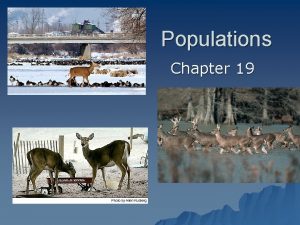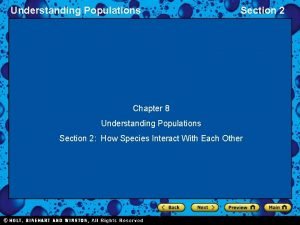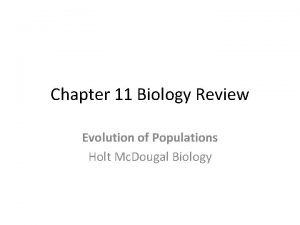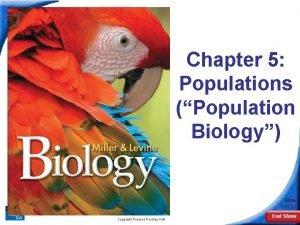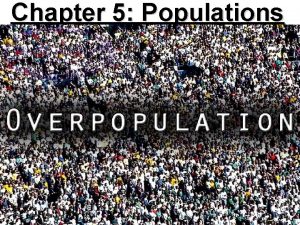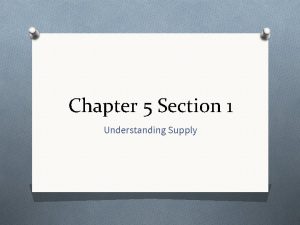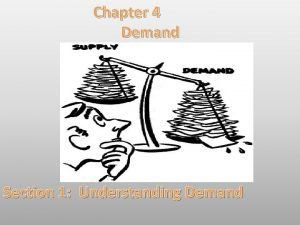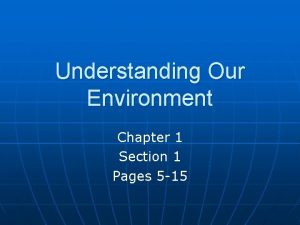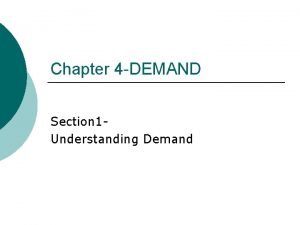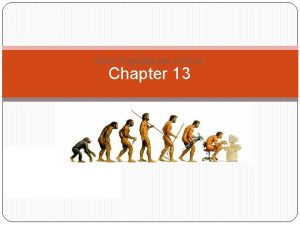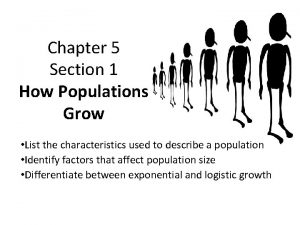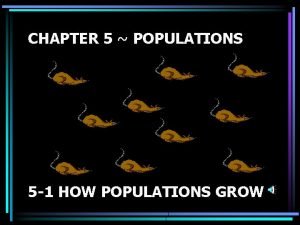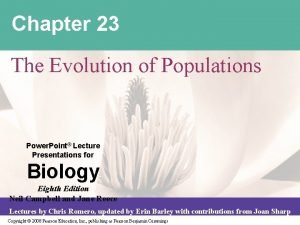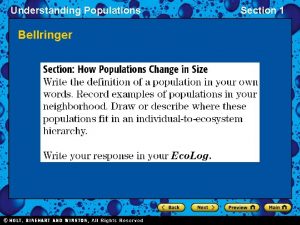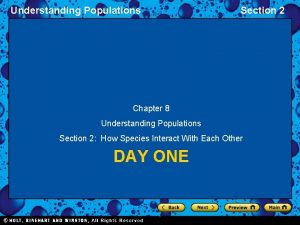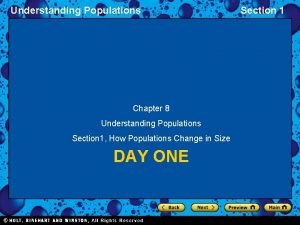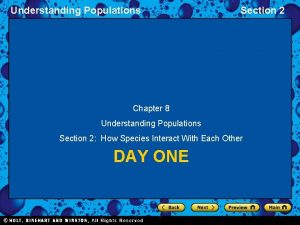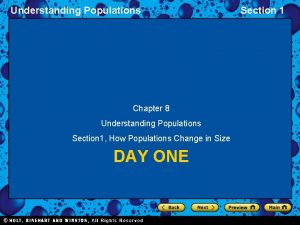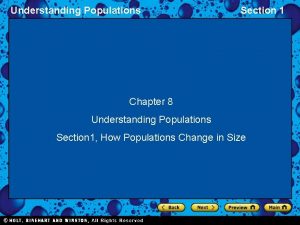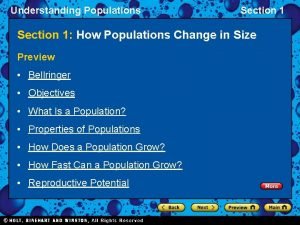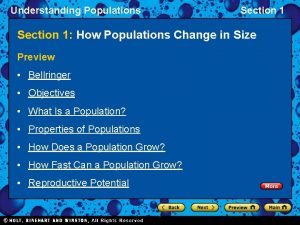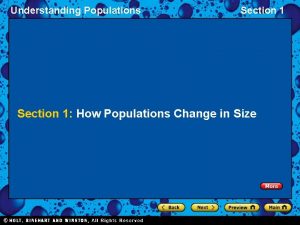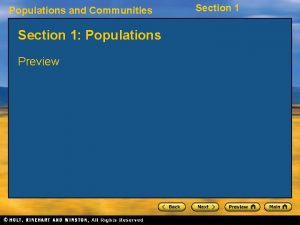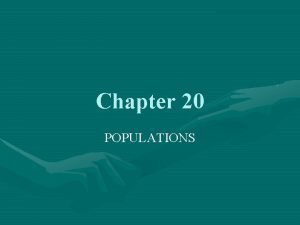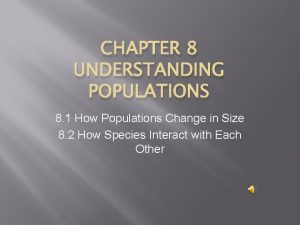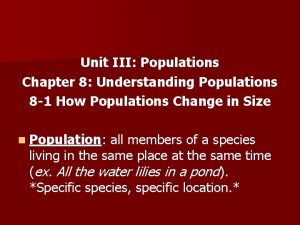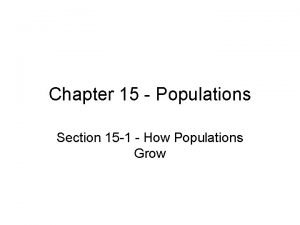Understanding Populations Section 2 Chapter 8 Understanding Populations




















- Slides: 20

Understanding Populations Section 2 Chapter 8 Understanding Populations Section 2: How Species Interact With Each Other

Understanding Populations An Organism’s Niche • A niche is the unique position occupied by a species, both in terms of its physical use of its habitat and its function within an ecological community. • A niche is different from a habitat. An organism’s habitat is a location. However, a niche is an organism’s pattern of use of its habitat. • A niche can also be thought of as the functional role, or job of a particular species in an ecosystem. Section 2

Understanding Populations Section 2 Symbiosis and Coevolution • Symbiosis is a relationship in which two different organisms live in close association with each other. • Symbiosis is most often used to describe a relationship in which at least one species benefits. • Over time, species in close relationships may coevolve. • These species may evolve adaptations that reduce the harm or improve the benefit of the relationship.

Understanding Populations Section 2 Ways in Which Species Interact • Interactions between species are categorized at the level where one population interacts with another. • The five major types of species interactions are: • Competition • Predation • Parasitism • Mutualism • Commensalism

Understanding Populations Species Interactions Section 2

Understanding Populations Ways in Which Species Interact • These categories are based on whether each species causes benefit or harm to the other species in a given relationships in terms of total effects over time. • Other types of interactions are possible. • Many interactions between species are indirect, some interactions do not fit in a category clearly, and other types seem possible but are rarely found. • Therefore, many interactions are neither categorized nor well studied. Section 2

Understanding Populations Competition • Competition is the relationship between two species (or individuals) in which both species (or individuals) attempt to use the same limited resource such that both are negatively affected by the relationship. • Members of the same species must compete with each other because they require the same resources because they occupy the same niche. • When members of different species compete, we say that their niches overlap, which means that each species uses some of the same resources in a habitat. Section 2

Understanding Populations Indirect Competition • Species can compete even if they never come into direct contact with each other. • For example, if one insect feeds on a certain plant during the day and another species feeds on the same plant during the night. • Because they use the same food source, the two species are indirect competitors. • Humans rarely interact with the insects that eat our food crops, but those insects are still competing with us for food. Section 2

Understanding Populations Section 2 Adaptations to Competition • When two species with similar niches are placed together in the same ecosystem, we might expect one species to be more successful than the other. • But in the course of evolution, adaptations that decrease competition will also be advantageous for species whose niches overlap. • One way competition can be reduced between species is by dividing up the niche in time or space.

Understanding Populations Adaptations to Competition • Niche restriction is when each species uses less of the niche than they are capable of using. • It is observed in closely related species that use the same resources within a habitat. • For example, Chthamalus stellatus, a barnacle species, is found only in the upper level of the intertidal zone when another barnacle species is present. • When the other species is removed, C. stellatus can be found at deeper levels. • The actual niche used by a species may be smaller than the potential niche. Section 2

Understanding Populations Adaptations to Competition Section 2

Understanding Populations Predation • Predation is an interaction between two species in which one species, the predator, feeds on the other species, the prey. • In complex food webs, a predator may also be the prey of another species. • Most organisms have evolved some mechanisms to avoid or defend against predators. Section 2

Understanding Populations Section 2 Predators • Some predators eat only specific types of prey. • In this kind of close relationship, the sizes of each population tend to increase and decrease in linked patterns, as shown below.

Understanding Populations Parasitism • An organism that lives in or on another organism and feeds on the other organism is a parasite. – Examples include ticks, fleas, tapeworms, heartworms, and bloodsucking leeches. • The organism, the parasite, takes its nourishment from is known as the host. • Parasitism is a relationship between two species, the parasite, benefits from the other species, the host, and usually harms the host. Section 2

Understanding Populations Section 2 Parasitism • The differences between a parasite and a predator are that a parasite spends some of its life in or on the host, and that the parasites do not usually kill their hosts. • In fact, the parasite has an evolutionary advantage if it allows its host to live longer. • However, the host is often weakened or exposed to disease by the parasite.

Understanding Populations Mutualism • Many species depend on another species for survival. In some cases, neither organism can survive alone. • Mutualism is a relationship between two species in which both species benefit. • Certain species of bacteria in your intestines form a mutualistic relationship with you. • These bacteria help break down food that you cannot digest. In return, you give the bacteria a warm, food-rich habitat. Section 2

Understanding Populations Commensalism • Commensalism is a relationship between two organisms in which one organism benefits and the other is unaffected. • An example is the relationship between sharks and a type of fish called remoras. • Remoras attach themselves to sharks and feed on scraps of food left over from the shark’s meals. • Even seemingly harmless activity, however, might have an effect on another species. Section 2

Understanding Populations Symbiosis via You. Tube Untamed Science Explains Symbiosis Section 2

Understanding Populations Section 2 Symbiosis Song – Something to Help You Remember Symbiosis Song

Understanding Populations Section 2 Ticket Out the Door • What is the difference between a niche and a habitat? • What is symbiosis? • What is competition? • What is predation? • What is mutualism? • What is parasitism? • What is commensalism?
 Section 19-1 review understanding populations answer key
Section 19-1 review understanding populations answer key Chapter 8 understanding populations
Chapter 8 understanding populations Stabilizing selection human birth weight
Stabilizing selection human birth weight Population growth concept map
Population growth concept map Evolution of populations section 16-1 genes and variation
Evolution of populations section 16-1 genes and variation Evolution of populations section 11 review
Evolution of populations section 11 review 5.1 how populations grow
5.1 how populations grow Parasitism
Parasitism Section 1 understanding supply
Section 1 understanding supply Lesson 1: understanding demand
Lesson 1: understanding demand Chapter 1 section 1 understanding our environment answers
Chapter 1 section 1 understanding our environment answers Economics chapter 4 section 1 understanding demand answers
Economics chapter 4 section 1 understanding demand answers Chapter 16 evolution of populations vocabulary review
Chapter 16 evolution of populations vocabulary review Chapter 13 how populations evolve test
Chapter 13 how populations evolve test Chapter 17 evolution of populations answer key
Chapter 17 evolution of populations answer key 5-1 how populations grow
5-1 how populations grow Chapter 5 lesson 1 how populations grow
Chapter 5 lesson 1 how populations grow Chapter 23 the evolution of populations
Chapter 23 the evolution of populations Section 16-1 genes and variation
Section 16-1 genes and variation Chapter 10 comparing two populations or groups answer key
Chapter 10 comparing two populations or groups answer key Chapter 23 the evolution of populations
Chapter 23 the evolution of populations
